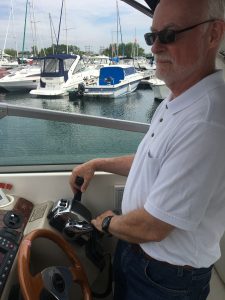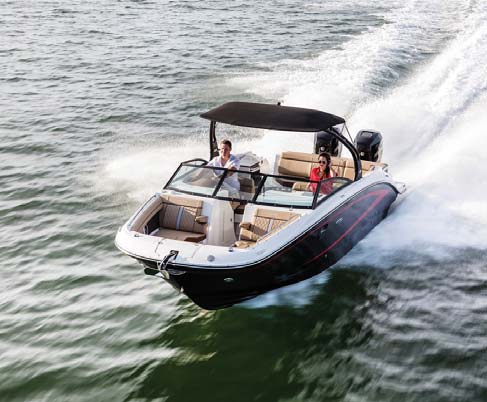Mastering The Bulldozer Turn

By Craig Hamilton
I remember well the first time I took a twin-engine stern drive boat off the dock and found it tougher than expected to control. I’d been told not to use the wheel, just the shifters to steer as this was the best and easiest way. So, I centered up the wheel and gave it a try. Instinctively, I went for the wheel and that just messed everything up for steering by shifters alone. Turning the wheel even a little changed the drive’s angle of thrust and made things confusing. Lesson learned – hands off the wheel if using this approach!
Twin versus single engine for maneuvering

There are basically three types of propulsion systems to be found on propeller-driven boats: stern drives, inboards, and pods. Each has advantages which can influence a choice of one system over the other. When choosing stern drives, it becomes necessary to pay special attention to the steering wheel when docking and for close quarters maneuvering.
Maneuvering a twin engine stern drive boat
Stern drives are an articulating steering system, meaning the wheel turns the twin drives (same as an outboard motor) which redirects thrust. But unlike an outboard, you can’t see them from the helm and if you shift into gear without knowing the wheel is turned, well, you maybe didn’t want to go that way.
Maneuver with or without the wheel, the choice is yours. But if you want a quick and efficient turn, put the wheel hard over and use the outside drive (i.e. starboard turn – use port drive). Using both drives will certainly turn the boat, but you add momentum and use more space because of the added thrust.
Docking with stern drives – wheel or no wheel?
Using the wheel makes things happen more quickly, while working with the shifters alone tends to slow things down. When there is wind or current, working quickly is necessary and often that means using the wheel and one or both drives. In calm conditions, there isn’t any need to rush and using the shifters alone with a centered wheel is my choice. Either way, use short shifts and a certain amount of drifting in neutral to control momentum.
You need to know your boat’s handling characteristics to find which works best for you. A port drive should push the bow to starboard in forward gear and pull the stern to starboard when in reverse. The opposite applies for the starboard drive. However, some stern drives aren’t perfectly balanced and this results in one turning better than the other. Here is how to learn the steering characteristics of your twin stern drive boat:
- Take the boat into safe water and bring it to a stop in calm conditions.
- Center the wheel.
- Shift the port drive into reverse with no throttle added. Does the stern go to starboard?
- Shift the starboard drive into reverse with no throttle added. Does the stern go to port?
- Try the same using a forward shift in relation to the bow.
If one drive understeers, shift the other drive into the opposite direction to compensate. I call this a rotation or “bulldozer” shift.
Word of advice
It doesn’t matter what type of boat you have, but it does matter to take the time to learn how to shift and steer efficiently in a safe, open area before attempting to maneuver in close quarters. If a shifter is stiff, or if you have difficulty finding neutral, have it looked at as this is a safety issue. And as always, give us at boaterskills.ca call if you need onboard instruction. Have a terrific, safe summer on the water!
Capt. Craig Hamilton is a Master Instructor at BoaterSkills.ca. You can reach him by email at craig@boaterskills.ca
Keyword : best boat, Best boat buying website, best boat marina website, best boat travel website, best place to rent a boat, boat accessories, boat angler, boat boondocking, boat buyers guide, boat camper, boat camping, boat dealers, boat DIY, boat Fishing, boat Fixer, boat Home, boat information, boat insurance, Boat Maintenance, boat marinas, boat marinas in Alberta, boat marinas in BC, boat marinas in Canada, boat marinas in Manitoba, boat marinas in Saskatchewan, boat marinas in the USA, boat marinas near me, boat products, boat rentals, boat repair, boat road test, boat sharing, boat sites near me, boat supplies, boat Tech, boat tips, boat touring, boat trade, boat Travel, boat traveling, boat travelling, boat vacation, boat vacation cost, boat websites Canada, boating Canada, Boating Canada’s Boat Lifestyle Magazine, Boating Lifestyle Magazine, boating website, Boatskills.ca, Canadian marina websites, docking, expert boat information, find a boat dealer, how much does a boat cost, how much does marina cost, how to choose a boat, how to drive a boat, Maneuvering, marina products, marina supplies, motor boat, power boating magazine, top boat website, Twin Stern Drives, used boat reviews best boat, Best boat buying website, best boat marina website, best boat travel website, best place to rent a boat, boat accessories, boat angler, boat boondocking, boat buyers guide, boat camper, boat camping, boat dealers, boat DIY, boat Fishing, boat Fixer, boat Home, boat information, boat insurance, Boat Maintenance, boat marinas, boat marinas in Alberta, boat marinas in BC, boat marinas in Canada, boat marinas in Manitoba, boat marinas in Saskatchewan, boat marinas in the USA, boat marinas near me, boat products, boat rentals, boat repair, boat road test, boat sharing, boat sites near me, boat supplies, boat Tech, boat tips, boat touring, boat trade, boat Travel, boat traveling, boat travelling, boat vacation, boat vacation cost, boat websites Canada, boating Canada, Boating Canada’s Boat Lifestyle Magazine, Boating Lifestyle Magazine, boating website, Boatskills.ca, Canadian marina websites, docking, expert boat information, find a boat dealer, how much does a boat cost, how much does marina cost, how to choose a boat, how to drive a boat, Maneuvering, marina products, marina supplies, motor boat, power boating magazine, top boat website, Twin Stern Drives, used boat reviews
